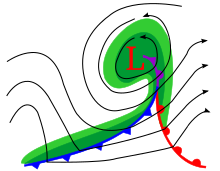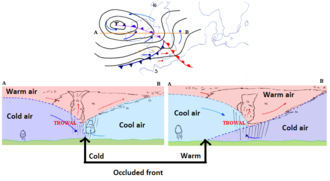Occluded front

In meteorology, an occluded front is a weather front formed during the process of cyclogenesis. The classical view of an occluded front is that they are formed when a cold front overtakes a warm front,[1] such that the warm air is separated (occluded) from the cyclone center at the surface. The point where the warm front becomes the occluded front is called the triple point; a new area of low-pressure that develops at this point is called a triple-point low.[2] A more modern view of the formation process[3] suggests that occluded fronts form directly during the wrap-up of the baroclinic zone during cyclogenesis, and then lengthen due to flow deformation and rotation around the cyclone.
Description[]

Occluded fronts usually form around mature low pressure areas. There are two types of occlusion, warm and cold:
- In a cold occlusion, the cold air mass overtaking the warm front is colder than the cool air ahead of the warm front, and plows under both air masses.
- In a warm occlusion, the cold air mass overtaking the warm front is warmer than the cool air ahead of the warm front, and rides over the colder air mass while lifting the warm air.
The occluded front symbol should thus be plotted at the position where the cold air is intersecting the surface, as on the adjacent image. It thus varies between warm and a cold occlusions. The trowal on the other hand, being the projection of the warm air trough aloft, is at the same position in both cases. The position of the occluded front on a surface weather analysis is often offset from the associated weather, which occurs at the trowal[4] (short for TROugh of Warm air ALoft), the projection on the Earth's surface of the wedge of warm air above the surface.[5]
Related weather[]

A cold front would be seen as spikes and a warm front as semi-circles in a traditional weather map. An occluded front is a combination of those two signs. They are indicated on a weather map either by a purple line with alternating semicircles and triangles pointing in direction of travel, or by red semicircles and blue triangles pointing in the same direction. On the other hand, a trowal is indicated by junction of blue and red lines like the junction of cold and warm fronts aloft.
A wide variety of weather can be found along an occluded front, with thunderstorms possible, but usually their passage is associated with a drying of the air mass. Additionally, cold core funnel clouds are possible if shear is significant along the cold front. Small isolated occluded fronts often remain for a time after a low pressure system has decayed and these create cloudy conditions with patchy rain or showers.
However, the clouds and precipitation are not really where the projection on the Earth's surface of the occluded front is, but with the trowal position.[4]
See also[]
- Extratropical cyclone
- Surface weather analysis
- Weather fronts
- Cold front
- Warm front
- Stationary front
References[]
- ^ University of Illinois. Occluded Front. Retrieved on 2006-10-22.
- ^ Djurić, D: "Weather Analysis". Prentice Hall, 1993. ISBN 0-13-501149-3.
- ^ Schultz, David M.; Vaughan, Geraint (2011-04-01). "Occluded Fronts and the Occlusion Process: A Fresh Look at Conventional Wisdom". Bulletin of the American Meteorological Society. 92 (4): 443–466. doi:10.1175/2010BAMS3057.1. ISSN 0003-0007.
- ^ Jump up to: a b Meteorological Service of Canada (January 2011). "9.5 Weather and Trowals" (PDF). AWARE. Environment Canada. pp. 82–83. Archived from the original (PDF) on 2016-08-07. Retrieved 2013-08-28.
- ^ "Trowal". World Meteorological Organisation. Eumetcal. Archived from the original on 2014-03-31. Retrieved 2013-08-28.
Schultz, D. M., and G. Vaughan, 2011: Occluded fronts and the occlusion process: A fresh look at conventional wisdom. Bull. Amer. Meteor. Soc., 92, 443–466, ES19–ES20.
External links[]
- A film clip AIR MASSES AND FRONTS - THE OCCLUDED FRONT (1962) is available at the Internet Archive
- Occluded Front.
- Weather fronts
